ICM 1/48 Ju-88A-5
Perhaps the most well-used aircraft in the Luftwaffe of the Second World War was the Junkers Ju-88 series. Originally designed as a Schnellbomber relying for defense on the ability to outrun enemy fighters, it was eventually used as a long range fighter and night fighter, as well as a deadly dive-bomber and torpedo bomber.
The prototype first appeared in 1936, and by 1945 16,000 aircraft of all variants had been built, more than any other German twin-engine aircraft. Design of the Ju-88 began in response to a 1935 RLM requirement for an unarmed, three seat, high speed bomber, with a payload of 800–1,000 kg. Study EF59 evolved into two parallel designs, Ju 85 and Ju 88, which appeared in 1936. The Ju-85 differed from the Ju-88 due to the use of a twin fin tail unit, and was never put into service. Use of annular radiators for the Jumo 211 engines meant that the aircraft could alternatively be powered by a radial engine, which happened with several sub-types.
By 1938, radical modifications from the first prototype in response to a 1937 RLM requirement promoted by Ernst Udet produced a "heavy" dive bomber. The wings were strengthened, dive brakes were added, the fuselage was extended, and the number of crewmen was increased to four. This redesign extended the development of the aircraft. Production was delayed drastically by developmental problems. Although planned for a service introduction in 1938, the Ju-88A-1 finally entered squadron service with only 12 aircraft on 1 September 1939. Production was painfully slow; only one Ju-88 manufactured per week, since problems continually kept cropping up. The Ju-88C heavy fighter was also designed very early in 1940, but kept secret from Göring, as he only wanted bombers.
The Ju-88A-1 was the first combat-ready version. The four man crew had three defensive 7.62mm machine guns. Power came from two Jumo 211B-1 or G engines. Use of the Ju-88A-1 in the Blitzkrieg revealed severe deficiencies in the aircraft, and they were modifed as rapidly as possible with the airframe modifications of the Ju-88A-4 which was expected to be the “definitive” bomber, while still utilizing the engines of the A-1. This sub-type was the Ju-88A-5 and it adopted increased rear upper defensive armament of two machine guns, which were later housed in the bulged rear canopy that would be used by the A-4. Ju-88A-1s were modified as rapidly as possible with the new A-4 wings and the aircraft first saw action in the Battle of Britain.
The first major combat was in the Norwegian campaign. On 9 April 1940, Ju-88s of I/KG 30 dive bombed and helped damage the battleship HMS Rodney and sink the destroyer HMS Gurkha in cooperation with Heinkel He 111s of KG 26. However, four Ju-88s were lost, the highest single loss of the aircraft in combat throughout the campaign.
Widespread use of the Ju-88 came with the Blitzkrieg in May 1940. Being particularly good as a dive bomber, Ju-88s claimed the destruction of 234-248 Allied aircraft on the ground between 10-13 May. Attacks on the French rail system between 11-24 May by I and II/KG 54 paralyzed French rail transport. On 17 June Ju-88s of KG 30 attacked and sank the ocean liner RMS Lancastria off St. Nazaire, killing 5,800 evacuated British and French troops.
Ju-88 losses in the Battle of Britain exceeded those of the Dornier Do 17Z and Heinkel He 111H, despite the Ju-88 being faster and deployed in smaller numbers than either of the others. Ju-88 losses over Britain in 1940 amounted to 303 aircraft between July and October 1940. Do 17 and He 111 losses for the same period amounted to 132 and 252 machines destroyed respectively. This was largely due to lack of experience in the aircraft on the part of crews who were newly converted onto it. Of 39 lost in July 1940, only 20 were the result of enemy action, the others being written off in training accidents, crashes or malfunctions over the Continent.
The first Ju-88A-4s appeared toward the end of the Battle of Britain, but the Ju-88A-5 soldiered on into early 1944, seeing action on all fronts.
Joachim Helbig - Bomber Ace:
The premiere Ju-88 bomber pilot of the war was Joachim Helbig, who was eventually credited with sinking 182,000 tons of Allied shipping in 480 missions.
Born in 1915, Helbig joined the Luftwaffe in 1936 and was an observer in Lehrgeschwader 1 (LG 1), the first unit to take the Ju-88 into action during the invasion of Poland. His two friends, Oberleutnant Fritz Sohler and Oberleutnant Gerhard Schröder, taught "Observer" Helbig to fly and he earned his Luftwaffe Advanced Pilot's Certificate (Erweiterter Luftwaffen Flugzeugführerschein), also known as the “C Certificate,” confirming proficiency on multi engine aircraft. Helbig's informal training was unique in the entire Luftwaffe.
Helbig saw further action in the Norwegian Campaign and the Battles of the Netherlands, Belgium and France. His most memorable mission was on 15 August 1940. He and his 4 Staffel took off from Orléans at 4:45 pm, with their primary target RAF Worthy Down. Over the English coast the formation of 200 Ju-88s from LG 1, Ju-87s from Sturzkampfgeschwader 1 (StG 1), escorted by Bf-110Cs of Zerstörergeschwader 2 (ZG 2), and Bf-109Es of Jagdgeschwader 27 (JG 27) and Jagdgeschwader 53 (JG 53), were intercepted by 14 squadrons of British fighters from 10 and 11 Groups totaling 170 Hurricanes and Spitfires. The mission turned out to be disastrous for Helbig's Staffel, with only Helbig and his crew returning in their heavily damaged aircraft. Thirty-two members of 4 Staffel were taken prisoner.
Helbig received the Knight's Cross on 9 November 1940. He then transferred to the Mediterranean theater of operations and operated against Malta, the British Mediterranean Fleet and in support of the Afrika Korps. Helbig was the 20th recipient of the Knight's Cross of the Iron Cross with Oak Leaves and Swords (Ritterkreuz des Eisernen Kreuzes mit Eichenlaub und Schwertern) on 28 September 1942 for support of Erwin Rommel's 1942 summer offensive and the sinking of 182,000 GRT of enemy shipping. This total included the sinking of the British destroyers HMS Kipling, HMS Jackal and HMS Lively off Crete on 11 May 1942. In response, in June 1942 British commandos attacked his unit at their base in Heraklion, and succeeded in blowing up seven of his Ju-88s.
Helbig's success in surviving seemingly hopeless situations was due to his excellent crew, which included Oberfeldwebel Franz Schlund who, on 30 August 1941, became the first Luftwaffe radio operator to be awarded the Knight's Cross. Schlund drove off attacking fighters on a mission against the Warrington Propeller Works located north of Liverpool and also contributed to the success of other missions, including the adestruction of the lock entrance to the Manchester Ship Canal at Eastham and the attack on the pilot training airfield at Penrose. In more than 200 combat missions, Schlund successfully fought off 13 attacks by enemy fighters.
In August 1943 Helbig was made Geschwaderkommodore of Lehrgeschwader 1 operating against the Allied invasion forces in Italy. His two notable successes were the bombing of the port of Bari in December 1943 in which an ammunition ship was blown up which nearly destroyed the harbor. On 30 January 1944, his Ju-88A-5, L1+AM, was destroyed in an aerial attack by American bombers. This aircraft, which was solely piloted by Helbig himself, was the only Ju-88 to survive more than 1,000 hours of combat operations. On the night of 12-13 May 1944, he led LG 1 and KG 30 on two missions to Corsica to bomb the 340th Bomb Group at Alesani Airfield. The 340th had lost all their B-25s two months earlier in the eruption of Mount Vesuvius, and had only 12 aircraft left after the Corsica raid. As one American said, “Those nice silver B-25s did a great job of reflecting the firelight to guide the Germans to their target.” Helbig's raid, the last bombing raid by the Luftwaffe on the Western Front, was memorialized in Joseph Heller's famous novel, “Catch 22" where Milo Minderbinder bombs his own airfield as part of a commercial business deal with the Germans.
The kit
This Ju-88 by ICM is the first 1/48 kit of this famous bomber to be released since Dragon's Ju-88 series was released 25 years ago, and the only Ju-88A-5 ever released in 1/48 (they also did it in 1/72). While it is already obvious ICM plans more Ju-88s (with the current release of the Ju-88A-4) they have eschewed Dragon's “modular” design philosophy that resulted in poor parts fit of all the kits.
The kit includes two Jumo 211 engines that are nicely detailed and can be displayed with the cowlings open. A full cockpit is included; several Experten have chimed in that it is not exactly accurate, but the fact is that once the canopy is on and the fuselage is closed up, this is not obvious to anyone not armed with a penlight.
Four decal options include Helbig's famous L1+AM, in its Battle of Britain markings and configuration.
I've built several of the Dragon series of kits, and this kit assembles far more easily than any of them. I first painted all the interior and detailed the parts prior to further assembly. I also constructed the basic engines, since they are needed to construct the whole engine cowling, but I did not detail them since I planned to close up the engine cowlings.
I assembled the cockpit and used Eduard Luftwaffe photo-etch seatbelts, my one deviation from building the model OOB. Once the cockpit was installed in the fuselage and the fuselage assembled, I then assembled each wing and the accompanying engine cowlings and nacelles. Fit overall was good;t I had to use seam filler on the main gear door (due to the way the nacelle was divided straight in half) and the panels for the cowlings (which may have been the result of my mis-fitting them) and the fuselage centerline. Do not attach the dive brakes at this time, as you have the underwing national insignia that lays down under the retracted flaps. Note that you do have to assemble the main gear and install them before attaching the engine nacelle, there is no way around this.
There is an option to lower the flaps, but the Ju-88 was not normally seen parked with the flaps down so I put them up, though I did “droop” the separate elevators. Overall assembly took under six hours, including time for glue to set up. I set the completed model aside overnight after attaching the forward section of the canopy and the “bug-eye” nose cap. Before I could proceed with painting, the clear parts needed masking. This was an involved process (there are a lot of separate glass panels) but Tamiya Tape and a sharp #11 blade eventually won the day.
The model was painted with Tamiya XF-27 Black-Green, XF-61 Dark Green and XF-23 Light Blue to do a RLM 70/71/65 “splinter” camouflage. The hard edges were masked off with drafting tape. I hand-painted the landing gear and gear wells with XF-22 RLM Grey and painted the wheels.
Kit decals were used and they were very good. A complete set of stenciling is provided. Be sure to have the area “well-watered” in order to get the decals into position because they do not want to move once they settle. A light coat of Mico-sol insured everything settled down into the surface detail. I used the markings for Helbig's famous L1+AM airplane.
I placed the guns in their proper positions, then glued the upper rear section of the canopy in place using Micro clear white glue, and attached the rear part of the lower gondola. I then attached the bombs.
A very nice model, more accurate than the Dragon kit as regards the earlier props, and certainly a better-fitting kit. The Ju-88 is an important airplane for anyone's World War II collection, and this kit can provide the basis for a highly detailed model if you want to put in the effort. The kit is not difficult in any way to assemble and provides an excellent result. Highly recommended.
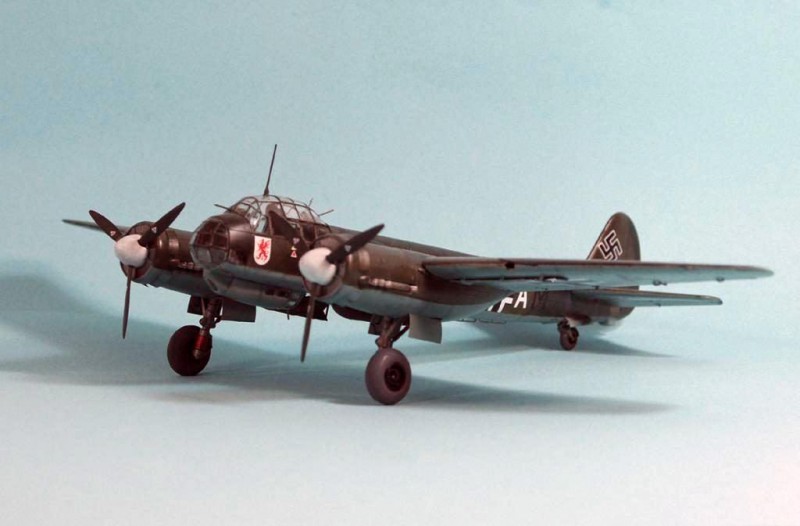
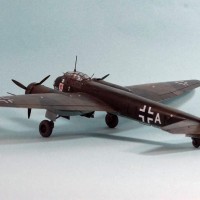
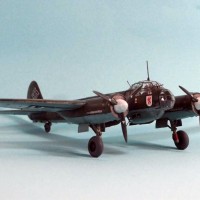
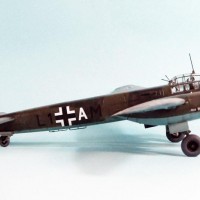
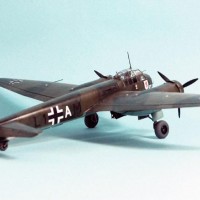


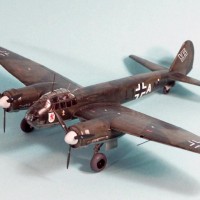
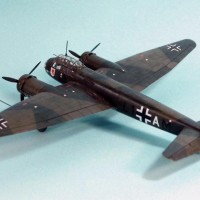
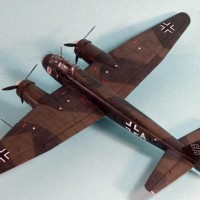
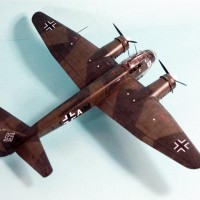
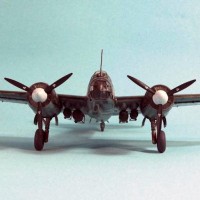
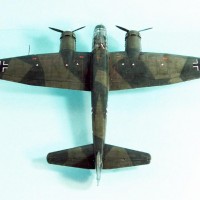
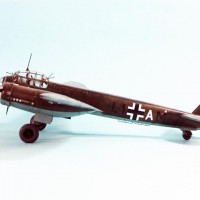
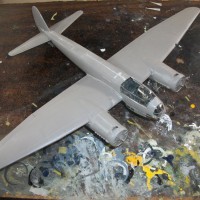
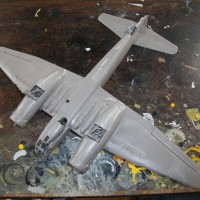
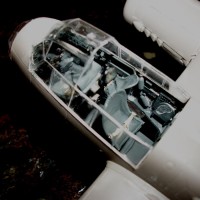
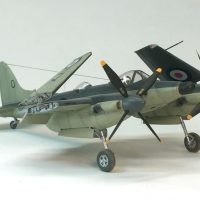

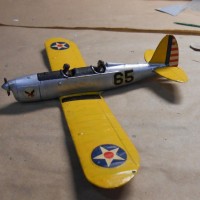
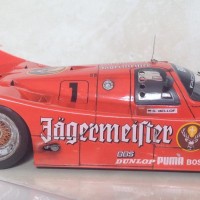
Nice work Tom……and a good read as well.
Great work. nice history.
Great to hear it goes together well. I'm so glad Icm are stepping up with sine grata subjects lately. I love the Do17s. Got two. 🙂 Great work on the 88.
Tom, first with the newest! Thanks, sounds easier than the modular Dragon.
A belated Happy Birthday!
Thanks! Had the very nice birthday present of "The Frozen Chosen" being released this coming Monday, and am currently negotiating the next book project. Not too bad for an Auld Phart.
Great job rendering the faded camouflage. And very intersting Historical note. Just a curiosity, the raid on Bari harbour was disastrous for the allied shipping, which lost severral ship and, unfortunately, a lot of casuality due to the chemical weapon carried by one of thee vassel.
Yes, it's never been proven, or admitted, but there is a belief there was some kind of nerve gas carried by one of the ships. It was the most damaging Luftwaffe bombing raid after the American invasion of North Africa.
Nice job Tom, enjoyed the article as well
Tail end Charlie echoing whats been written. The usual thoughtful article with a history of the aircraft and the pilot who beat the odds. Whats there not to like. Appreciate the in progress photo's showing the seam lines and the unpainted plastic.
Nice!
I wonder how much is difficult to build ICM ?
Years ago, I worked on Dragon the pain and a*s sweat and litanies.
I think about buy ICM to build in Ju-88 A4 in Finland service.
While waiting for some aftermarket is already Vektor offered..
P.k
Have you finished yet, sorry, I fell asleep!
Nice looking build Tom, as usual.
I am having a mother of a battle with the Special Hoby version of this! Fitting the floor/cockpit to the upper half is very awkward. The instructions are not that clear as to where to position the side panels to the cocpit walls and I think that is the root of my problems.